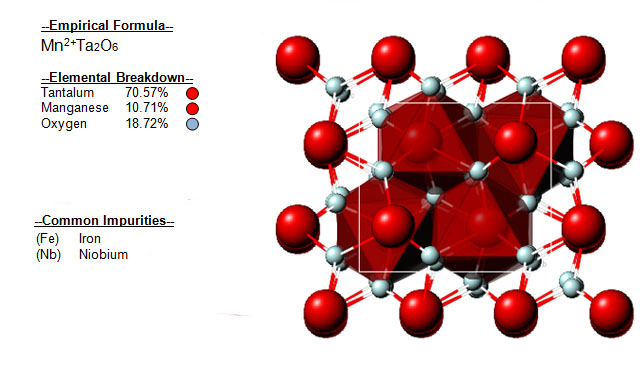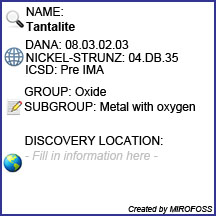

| Mineral Name | Tantalite |
| First Discovered | 1887 |
| Nickel-Strunz Classification | 04.DB.35 |
| Dana Classification | 08.03.02.03 |
| ICSD | Pre IMA |
| Mineral Group | Oxides |

| Cleavage | Imperfect |
| Colour(s) | Black, Brown |
| Specific Gravity | 8.10 |
| Diaphaneity | Opaque |
| Fracture | Brittle - Uneven - Very brittle fracture producing uneven fragments |
| Mohs Hardness | 6.0 to 6.5 |
| Luminescence | Non-fluorescent |
| Luster | Sub metallic |
| Streak | Brown |
| Habit(s) | Crystalline to Disseminated to Massive |
| Radioactivity | Non-radioactive |
| Magnetism | Non-magnetic |

The following health hazards should be noted when handling tantalite
 |
TOXIC Tantalite contains the rare element tantalum which is defined as being highly toxic. |
 |
ENVIRONMENTAL HAZARD Tantalite contains the rare element tantalum which is defined as being an environmental hazard if allowed to enter the local ecosystem. |

The following image shows the Elemental breakdown of the mineral tantalite along with the mineral crystal structure.


| Crystal System | Orthorhombic |  |
| Class | Dipyramidal | |
| Axial Ratios | a : b : c = 0.399 : 1 : 0.3523 | |
| Morphology | Short prismatic to tabular | |
| Optical Data Type | Biaxial (+) | |
| Pleochroism (x) | Red | |
| Pleochroism (y) | Redish brown | |
| Pleochroism (z) | Orange | |
| RL Values | nα = 2.140 nβ = 2.150 nγ = 2.340 |  |
| 2V | N/A | |
| Max Birefringence | δ = 0.200 (See colour chart at right) | |
| Surface Relief | Very high | |
| Dispersion | Strong r < v |

Tantalite can be referenced in certain current and historical texts under the following three names:
The mineral tantalite can be translated into the following select languages:
| Arabic | تاتنتالايت | Bulgarian | танталит | Chinese (Sim) | 钽锰矿 |
| Croatian | tantalitu | Czech | Danish | ||
| Dutch | tantaliet | Esperanto | Estonian | ||
| Finnish | French | German | Alvarolit | ||
| Greek | Τανταλίτης | Hebrew | Hungarian | ||
| Italian | Japanese | タンタライト | Korean | 탄탈 | |
| Latin | Lithuanian | tantalitas | Norwegian | tanta | |
| Persian | تانتالیت | Polish | tantalit | Portuguese | tantalita |
| Romanian | tantalit | Russian | Мангантанталит | Slovak | |
| Spanish | Alvarolita | Swedish | tantalit | Tagalog | |
| Turkish | Ukrainian | Танталіт | Vietnamese |


 |
The MIROFOSS database offers free printable geological identification tags for personal and non-profit use. These tags can be used to properly identify mineral samples in your collection. -Click here- to download a full size jpeg image for a tantalite identification tag; which can be printed on paper or used with a plastic laser printer. |
 |
What's this? What can I do with it? |

| Crystallography | Palache, Charles, Harry Berman & Clifford Frondel (1944), The System of Mineralogy of James Dwight Dana and Edward Salisbury Dana Yale University 1837-1892, Volume I: Elements, Sulfides, Sulfosalts, Oxides. John Wiley and Sons, Inc., New York. 7th edition, revised and enlarged: 780. |
| Optical Data | Grice, J. D., Ferguson, R. B., Hawthorne, F. C. (1976): The crystal structures of tantalite, ixiolite and wodginite from Bernic Lake, Manitoba. I. Tantalite and ixiolite. Canadian Mineralogist 14, 540-549. [in fact structure of manganotantalite] |
| History | American Mineralogist (1988): 73: 666-667 American Mineralogist (1995): 80: 613-619. |
| Geograpcial Data | Mindat.org. Retrieved on 2012-03-05 |
| Physical Identification | Webmineral.com. Retrieved on 2012-03-05. |
| June 18, 2014 | The last time this page was updated |
| ©2017 MIROFOSS™ Foundation | |
 |